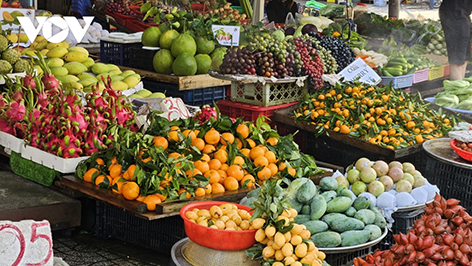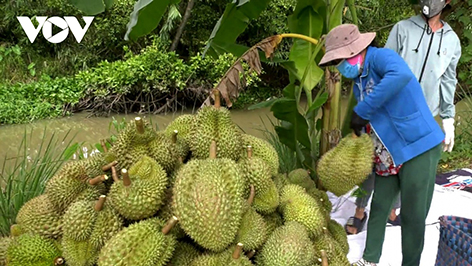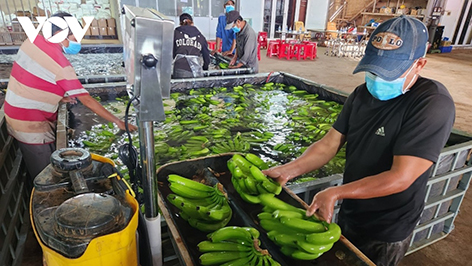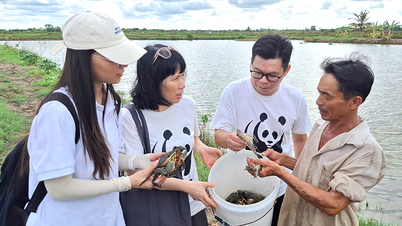Vietnam's fruit and vegetable industry aims to export from 6 to 6.5 billion USD in 2024. To achieve this goal, facing difficulties in European and American markets, Vietnam's fruit and vegetable industry focuses on the traditional Chinese market and promotes exports to Southeast Asian countries such as Indonesia, Malaysia, Thailand, etc.
In which, direct trade with some countries with similar products is expected to increase value and reduce risks for Vietnamese agricultural products.
Cooperate with competitors, why not?
Chanthaburi is a leading province in Thailand's agricultural output, especially fruit growing, typically including durian, rambutan, mangosteen, pineapple, jackfruit, longan, etc. This is also a long-time tropical fruit trading partner of China. In recent times, Vietnam and Thailand have had many similar products focusing on exporting to the country of a billion people.
Vietnam’s agricultural products exported to China are facing fierce competition from the land of pagodas. One of Vietnam’s limitations is related to high production costs, mechanization, unstable product quality and brand building.
In addition, the issue of joint ventures and partnerships in production has not yet met import-export regulations well... Therefore, there are still contracts between businesses and manufacturers, and farmers are being charged higher prices due to intermediaries. In some markets, there are times when Vietnamese fruits and vegetables are disadvantaged when exported, when labels must be attached to other countries.
Limitations of Vietnam's export activities are due to high production costs, mechanization, unstable product quality cultivation processes, and brand building. (Photo: Nguyen Quang)
According to Mr. Nguyen Van Muoi, Head of the Southern Office of the Vietnam Gardening Association: Thailand has a long history of exporting agricultural products, including vegetables and fruits in both fresh, frozen and dried forms. Vietnam, on the other hand, mostly exports fresh. Therefore, a new perspective on trade is needed to increase the value of agricultural products.
Mr. Muoi added: "In fact, it is not when two countries have similar products that we become competitors. For example, Vietnam is one of the countries that has the advantage of being able to produce durian all year round, while Thailand only focuses on production at a certain time from April to September. Therefore, Thai businesses also need to buy our products to meet their orders in the Chinese market."
Mr. Ukrit Wongthongsalee, President of Chanthaburi Chamber of Commerce (Thailand), said that Chanthaburi is a leading province in Thailand famous for its agricultural output, especially fruit growing. In addition, it is also the capital of many other tropical fruits. Through its media channels, Chanthaburi will provide information and promote Vietnam's activities, taking advantage of its advantages to promote international trade.
According to Mr. Ukrit Wongthongsalee: "We want to cooperate with Vietnamese farmers and farms. In the coming time, we will also create favorable conditions for Vietnamese enterprises to participate in promotional activities in Thailand. Through this cooperation, we will promote opportunities for businesses of both countries to increase trade and expand markets for vegetable, flower, fruit products... This is also the best choice and solution to help consume products of both countries."
There are still contracts between businesses and producers, and farmers are being charged higher prices due to intermediaries. (Photo: Nguyen Quang)
Increase forecasting, reduce intermediaries
The Vietnam Fruit and Vegetable Association expects that in 2024, the export turnover of fruits and vegetables can reach 6.5 billion USD. If all goes well, it can reach 7 billion USD, higher than the target of 6 billion USD. However, many markets, including Europe and the US, are currently facing difficulties. To achieve this goal, the fruit and vegetable industry is shifting to the Chinese and Southeast Asian markets.
According to Mr. Nguyen Nhu Cuong, Director of the Department of Crop Production - Ministry of Agriculture and Rural Development , businesses in the industry must seize the opportunity, proactively stabilize traditional markets. At the same time, solve necessary and sufficient problems to expand new markets. As well as through effective production organization, enhancing forecast information, reducing the role of intermediaries to increase value in transactions...
Vietnam expects fruit and vegetable export turnover to reach 6.5 billion USD in 2024. If all goes well, it could reach 7 billion USD, higher than the set target of 6 billion USD. (Photo: Nguyen Quang)
"At the same time, we need to identify key strategic products to have solutions on market, technology and production. For example, durian, grapefruit, coconut... These are products with a lot of potential, along with many other products with great potential for development" - Mr. Cuong emphasized.
Regarding issues of market expansion, Mr. Le Thanh Hoa, Deputy Director of the Department of Quality, Processing and Market Development - Ministry of Agriculture and Rural Development, said that recently, the units of the ministry have continuously negotiated with major markets, including China, New Zealand, the United States, Japan, etc., to expand the market for many types of vegetables and fruits.
In particular, the Chinese market is a large market that has contributed greatly to promoting the export turnover of fruits and vegetables, including tropical fruits of Vietnam in the past year. In the coming time, the export of fruits and vegetables needs to better meet the regulations of the market. Especially the issue of quality assurance, food safety and the construction and supervision of the production process.
In the coming time, fruit and vegetable export activities need to better meet market regulations. (Photo: Nguyen Quang)
"The Ministry has also coordinated to organize conferences and seminars to help connect buyers and producers directly to reduce intermediary costs. We will also support linkages to promote product consumption. There will also be specific instructions on market regulations so that producers and businesses can better meet market regulations in the coming time," Mr. Hoa stated.
2024 is expected to be very favorable, especially the Chinese market. Because currently this country has opened almost all border gates, trails, and even wants to cooperate to promote the construction of smart border gates to facilitate the import of fruits and vegetables with Vietnam. Therefore, improving supply capacity, direct transactions, and even joining hands with countries that share the same market are also flexible directions to increase value, reduce risks, and effectively consume agricultural products in the coming time.
According to Nguyen Quang/VOV-HCMC
Source







![[Photo] National Conference "100 years of Vietnamese Revolutionary Press accompanying the glorious cause of the Party and the nation"](https://vphoto.vietnam.vn/thumb/1200x675/vietnam/resource/IMAGE/2025/5/30/1cf6cd5c8a934ebfa347028dcb08358c)

![[Photo] A delegation of 100 journalists from the Vietnam Journalists Association visits the soldiers and people of Truong Sa island district.](https://vphoto.vietnam.vn/thumb/1200x675/vietnam/resource/IMAGE/2025/5/30/0984a986227d4e988177f560d2e1563e)
![[Photo] General Secretary To Lam receives Chief of the Central Office of the Lao People's Revolutionary Party](https://vphoto.vietnam.vn/thumb/1200x675/vietnam/resource/IMAGE/2025/5/30/140435f4b39d4599a3d17975dfb444c5)
![[Photo] Journalists moved to tears at the Memorial Service for the soldiers who died in Gac Ma](https://vphoto.vietnam.vn/thumb/1200x675/vietnam/resource/IMAGE/2025/5/30/9454613a55c54c16bf8c0efa51883456)












































































Comment (0)